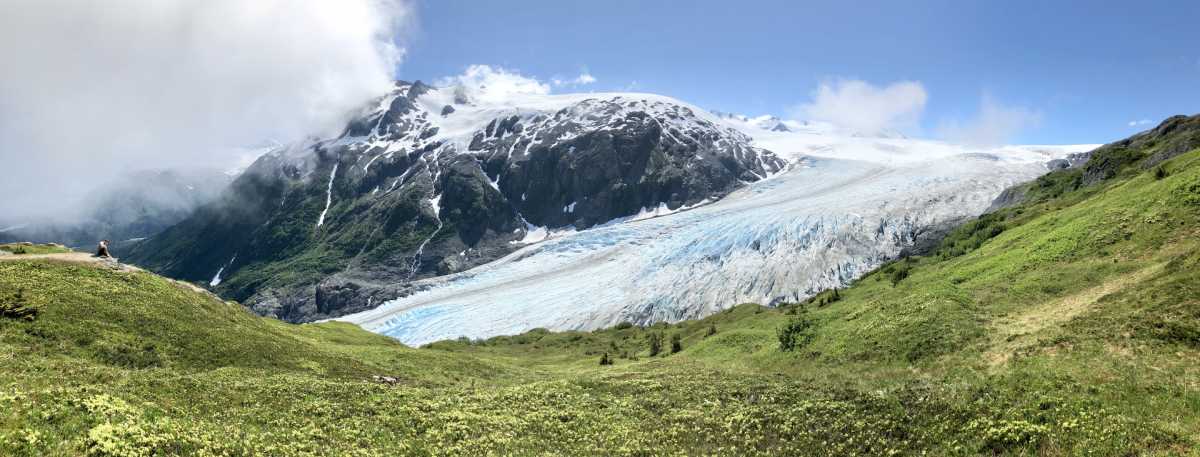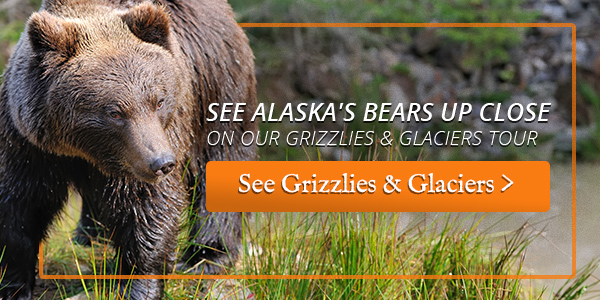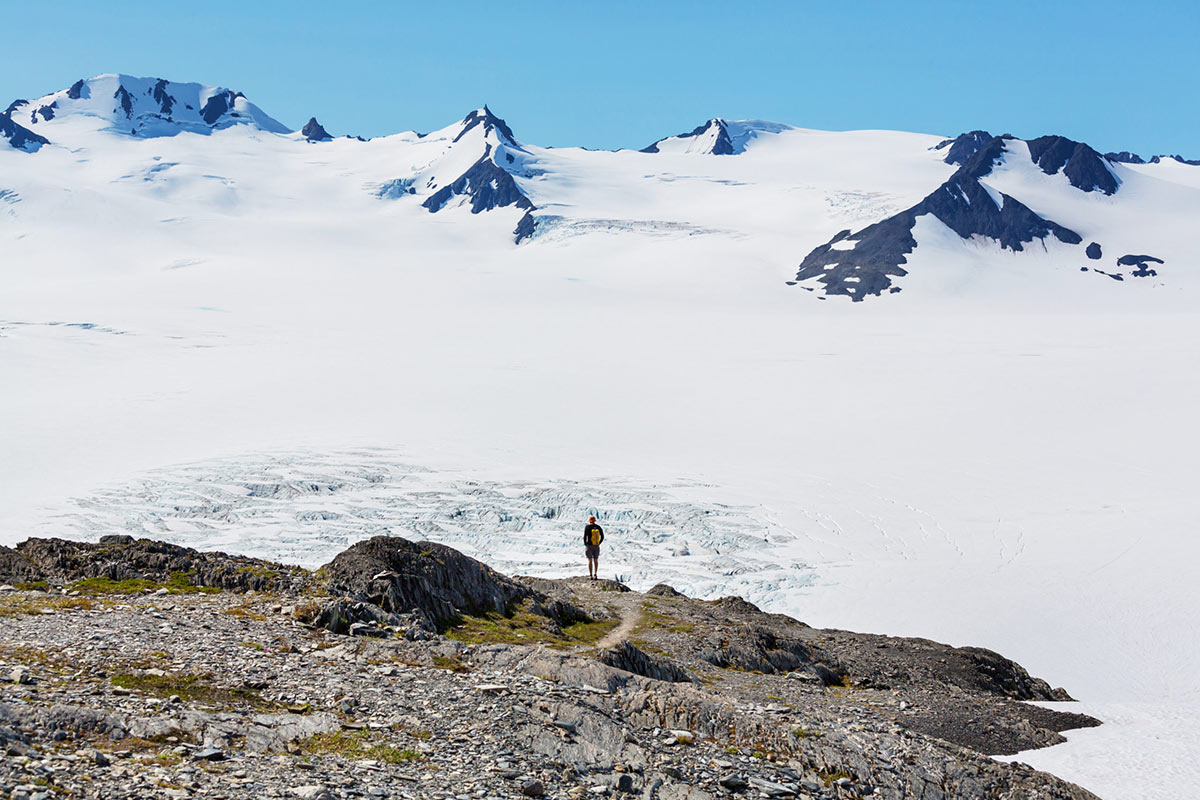 Exit Glacier in Kenai Fjords National Park is not the largest nor the oldest glacier in Alaska, but it’s arguably one of the most famous. The landscape is captivating and it has become a symbol of the environmental impact of climate change. It’s also an important and favorite stop on our Glaciers & Grizzlies Adventure tour. Which is why we’d like to share with you some fascinating facts about the small glacier that’s made a big impact on travelers and environmentalists from all over the world!
Exit Glacier in Kenai Fjords National Park is not the largest nor the oldest glacier in Alaska, but it’s arguably one of the most famous. The landscape is captivating and it has become a symbol of the environmental impact of climate change. It’s also an important and favorite stop on our Glaciers & Grizzlies Adventure tour. Which is why we’d like to share with you some fascinating facts about the small glacier that’s made a big impact on travelers and environmentalists from all over the world!
1. Glaciers make up about 10 percent of the Earth’s surface.
During the last Ice Age, however, they covered nearly one-third of the planet. This means that around 15,000 years ago, ice encased most of North America and extended as far south as California’s San Bernardino Mountains.¹
It is truly remarkable to reflect on the significant changes that have occurred in Earth’s landscape over the millennia. The retreat of glaciers marks a pivotal moment in our planet’s history, shaping not only its physical geography but also influencing climate patterns and habitats for countless species. As glaciers continue to recede due to ongoing climate change, it becomes imperative for us to understand and address the environmental impacts of these changes. Our actions today can determine the future of these majestic icy giants and the delicate balance of our global ecosystem.
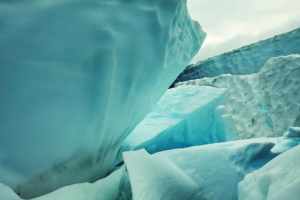
Glacier in Alaska
2. Over 100,000 glaciers exist in Alaska today, covering nearly 28,000 square miles.
Most of them remain nameless, but a few, like Exit Glacier, have become popular tourist destinations.²
Visiting these glaciers not only offers a breathtaking view of the icy landscapes but also provides a stark reminder of the impact of climate change. As temperatures continue to rise, these glaciers are receding at an alarming rate, with some experts predicting that they might disappear entirely within the next century. The loss of these glaciers could have devastating effects on the local ecosystems and communities that depend on them for freshwater and tourism. Efforts to raise awareness about the importance of preserving these natural wonders have increased, with scientists and environmentalists advocating for sustainable practices to mitigate the effects of climate change on Alaska’s glaciers.
3. Not just any chunk of ice can be called a glacier. There is a size requirement.
They have to be at least 25 acres or the equivalent of 19 football fields. Exit Glacier easily makes the cut measuring about 14 square miles.³
In addition to the size requirement, glaciers must also exhibit movement. Glaciers are defined as large bodies of ice that flow under their own weight due to the pressure of their accumulated snowfall. This movement is what distinguishes glaciers from static ice formations. Exit Glacier, located in Kenai Fjords National Park in Alaska, showcases this characteristic as it slowly flows down the valley, constantly reshaping the landscape over time. Understanding these criteria helps us appreciate the dynamic nature of glaciers and their role in shaping the Earth’s surface.
4. Glaciers have been around for longer than you think.
Scientists have found an ice field in Antarctica which they estimate to be 1.5 million years old!4 Exit Glacier is young by comparison. It’s part of the Harding Ice Field, which has only been around for about 23,000 years.5
The discovery of such ancient ice fields in Antarctica sheds light on the remarkable resilience and longevity of glaciers on our planet. These findings not only provide crucial insights into the Earth’s climatic history but also serve as a stark reminder of the urgent need to address the rapid changes occurring in these icy landscapes due to human activities and climate change. As we continue to unravel the secrets hidden within these frozen relics of the past, it becomes increasingly evident that preserving these natural wonders is essential for understanding our planet’s history and protecting its future.
5. Do you know how glacial ice gets to be so blue? It’s because it’s so dense.
Years of falling snow are compacted tightly into sheets leaving no room for air. When the light hits these sheets, it absorbs all the other colors on the spectrum except for blue light, which has a shorter wavelength.
This phenomenon results in the ice appearing blue to our eyes. Moreover, the depth of the ice plays a role in intensifying the blue color. The thicker the ice, the more pronounced the blue hue, as the ice absorbs and scatters light differently depending on its density. Glacial ice’s captivating blue shade not only serves as a visual spectacle but also holds profound insights into the science of light and ice formation. Understanding the intricacies behind this natural wonder adds a layer of appreciation for the beauty and complexity of our planet’s icy landscapes.
6. Exit Glacier is just one of 35 glaciers that make up the Harding Ice Field in the Kenai Mountains of Alaska.
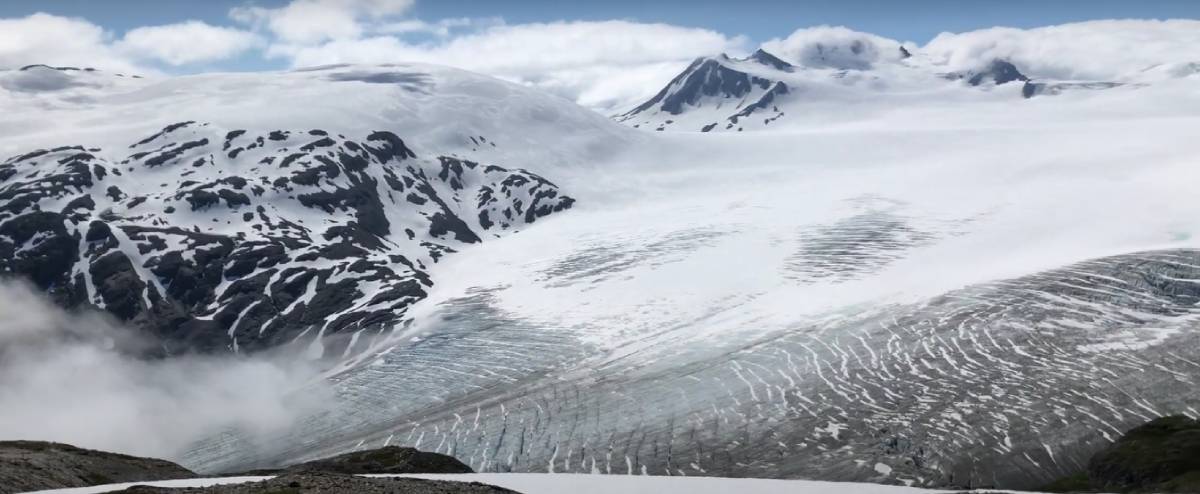
Harding Ice Field
In 1968, an expedition successfully crossed the ice field for the very first time. At the end of their journey, they exited the ice field by descending a glacier they later named “Exit” to commemorate the event.
This historic expedition marked a significant milestone in the exploration of the Kenai Mountains and the Harding Ice Field. Over the years, Exit Glacier has not only become a symbol of human perseverance and discovery but also a reminder of the impact of climate change. As temperatures rise and glaciers retreat at a surprising rate, the very existence of these icy giants is under threat. Despite the challenges ahead, the legacy of those brave explorers lives on in the shimmering ice and majestic landscape of Exit Glacier, inspiring future generations to cherish and protect our planet’s precious natural wonders.
7. While Exit Glacier is not the oldest or largest glacier in Alaska, it is the most accessible.
It is a 10-15 minute drive from Seward, Alaska, and only a 15-20 minute walk from the parking lot to the toe of the glacier. The path is also paved for wheelchair and stroller access allowing travelers of all ages and ability levels to get up close to the glacier.6
The ease of access to Exit Glacier makes it a popular destination for tourists looking to witness the stunning beauty of a glacier without the need for extensive hiking or specialized equipment. The short distance from Seward, combined with the paved path leading to the glacier, offers a unique opportunity for visitors to experience the awe-inspiring sight of a glacier up close. This accessibility not only allows for a memorable experience but also ensures that individuals with mobility limitations can also partake in the adventure, making it a must-visit attraction for anyone exploring the wonders of Alaska’s natural landscapes.
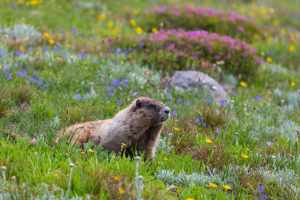
Alaskan Marmot
8. The Exit Glacier isn’t the only sight to see in the area.
It’s part of Alaska’s Kenai Fjords National Park and home to a wild variety of animals and birds including mountain goats, bears, moose, eagles, and marmots.
Visitors to Kenai Fjords National Park can explore the intricate network of fjords, ice fields, and towering glaciers that define this pristine wilderness. Boat tours offer the chance to witness calving glaciers and spot marine wildlife such as whales, sea otters, and puffins in their natural habitat. Hiking trails wind through lush forests and alpine meadows, providing opportunities to encounter diverse flora and fauna up close. For those seeking adventure, kayaking along the icy waters offers a thrilling way to experience the untamed beauty of this remote corner of Alaska.
9. Exit Glacier has become an icon of climate change.
Starting in the 1800s, markers have been posted along the trail as a visual reminder of the glacier’s retreat. It’s been melting at a rate of roughly 162 feet per year since 2010.7
As visitors walk along the trail, the markers serve as poignant symbols of the stark reality of our changing climate. The once mighty glacier now stands as a testament to the urgent need for action to mitigate the impact of global warming. The alarming rate at which Exit Glacier is receding underscores the pressing need for sustainable practices and policies to combat climate change before more natural wonders face a similar fate. It is a sobering reminder that we must act swiftly and decisively to protect our planet for future generations.

Georeferenced aerial photographs of Exit Glacier taken in 1993, 2005, 2006 and 2007. NPS Image
10. Visiting Exit Glacier was on President Obama’s bucket list.
In 2015 President Obama made the hike to the Exit Glacier before giving a speech addressing climate change at a conference in Anchorage. He called the glacier itself “spectacular” and expressed his hope that it would still be around for future generations to visit.8
Read about more tours to Alaska! The best time to see the northern lights in North America is typically during the winter months, from late September to early April, when nights are longest and skies are darkest. Prime viewing locations include northern regions such as Alaska, Canada’s Yukon Territory, and parts of northern United States like Maine and Minnesota. With clear, dark skies and a bit of luck, spectators can witness the awe-inspiring dance of the aurora borealis illuminating the northern horizon.
¹Baehr, Leslie.”A Terrifying GIF Of An Ice Age Ripping Through The US,” Business Insider. ²Leibowitz,Elissa.”Ten Interesting Facts about Glaciers.” World Wildlife Fund. ³Rosen,Yereth.”Retreating Exit Glacier has become an icon of climate change.” Anchorage Daily News. 4Glumac, Tamara. “Scientists discover Antarctic ice sheet believed to be 1.5 million years old.” ABC News. 5“The Harding Icefield.” National Park Service. 6“Visit Exit Glacier.” Alaska.org. 7Yore, Linda Malys. “15 Things To Know Before Visiting Exit Glacier Alaska (Safety, Packing, & Hiking).” Linda On The Run. 8Mufson, Steven. “Obama visits receding glacier in Alaska to highlight climate change.” The Washington Post.

